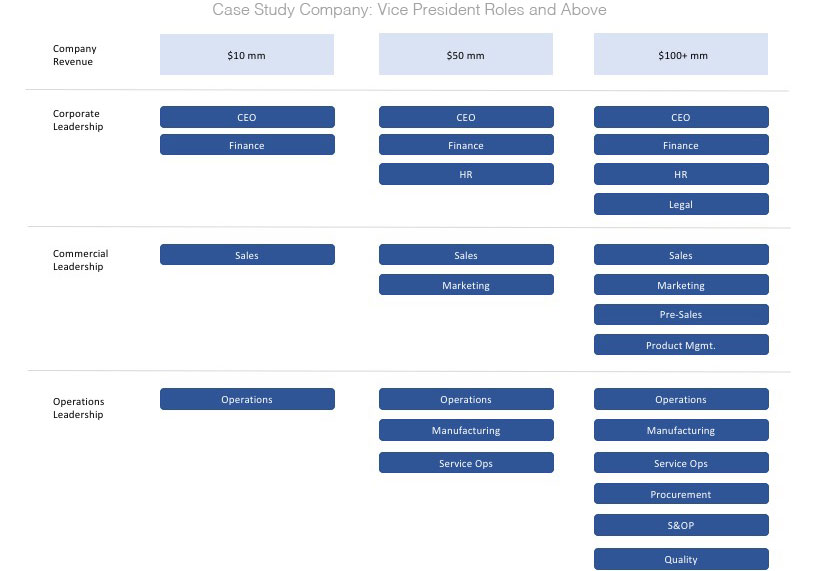
Building Functions to Support Growth: Getting It Right
Building Functions to Support Growth
Growth PE funds invest in middle market companies seeking capital for expansion. These companies range from fast-growing consumer brands, to pharmaceutical companies with successful new therapies, to manufacturing companies delivering innovative technologies. Revenues are in the middle tens to several hundred million, often with aspirations to grow several times current size.
Whether or not they’ve taken venture capital, these middle market companies have made it beyond the venture phase. They are established in the market, they have customers and operations, and they have momentum. Technology innovation and market risks have faded. The challenge is now execution: growing revenues profitably, developing channels and product suites, scaling capabilities.
The question is, what sort of talent do you need to scale a mid-sized company?
Finding the Right Talent: Mini Case*
A B2B manufacturing company with patented technologies serving several niche markets had been growing steadily. When the company reached $50 million, they transitioned leadership from the founder to an experienced CEO, who then professionalized Marketing, Manufacturing and Human Resources.

As the company reached $100 million, they had achieved meaningful brand recognition. Ready to further accelerate, they partnered with a PE fund to help with plans for new products and geographic expansion. A CFO joined the team, and the company started adding territories and customizing products for international markets.
As they grew to $250+ million, however, operating strains and quality issues emerged, and leadership turned their attention to the supply chain team. In particular they wanted to bring in accomplished leaders to build Procurement, S&OP and Quality as strong functional capabilities.
While most of the new operations leaders were successful, their first Procurement leader was not.
- First Try: Academy Player. Their first hire as VP, Procurement was a product of two academy organizations—i.e., highly regarded Fortune 500 supply chain organizations. This individual had lived world-class procurement. He knew what spend analytics should look like, could talk in detail about the seven-step sourcing process, and was strong on procurement operations and compliance. But the transition from a $5+ billion company to a $250 million company was rocky. He did not have the systems or the data that he was accustomed to, and he was reluctant to act without all the facts. He was also relied on rules instead of persuasion, and quickly become perceived as “too corporate.” Procurement did not achieve the liftoff expected.
- Second Try: The Builder. The second hire had early academy experience, but then moved to China to start an independent marketing company. Later, she took on two successive roles leading supply chain for middle market companies with contract manufacturing in Asia. She was accustomed to building functions from scratch with limited resources and infrastructure. She was also a natural relationship-builder known for a flexible, practical working style. When she took over as VP, Procurement, she approached the power centers (Engineering and Manufacturing) with a partnership mentality. What were their biggest pain points and how could he help? She was quickly on a plane to Asia to resolve a difficult supply situation. Before long, the Procurement function was penetrating the business, driving cost improvements that have powered the company’s growth.
A Checklist for Function Builders
When building out functions to support a company’s growth, it’s natural to seek leaders who know what excellence looks like. But knowing what excellence is, and understanding how to navigate there, are different topics. Make sure you hire for both.
To hire the right leaders to build key functions, consider these criteria.
- They know excellence. They have succeeded in high performance environments and/or worked with top leaders in their function. They operate with clarity around the costs and benefits of investing in functional capabilities, systems, and processes. They are not guessing at a desired future state.
- They face down ambiguity. They have previously worked and thrived in challenging, under-resourced business environments. They know how to create value even if systems, processes, and data are lacking. They do not hesitate to execute on the 80/20 rule.
- They go for momentum. They build momentum with base hits, demonstrating the value of the new team and function. Early wins may be against pain points dictated by the business ( ones surfaced by the function). If first wins are not large, they are still measurable and appreciated.
- They build relationships. They understand that beach-heading a function means establishing new methods for how business gets done within a company. So they reach out to peers and power-centers across the company to listen and build connectivity and trust.
- They have some breadth. In growing midsized companies, functional leaders will often be asked to problem-solve outside their immediate swim lane. The CFO who has HR and ERP experience, or the materials head who understands logistics, is much more helpful than a siloed functional leader.
Confirmation Bias
Confirmation bias means that we prioritize and privilege evidence that supports what we already believe to be true, and we avoid looking for evidence that contradicts our assumptions.
In hiring, confirmation bias can translate into using short cuts. Resumes can be shiny objects, and candidates from well-known companies can look good on paper and perhaps interview even better.
Just make sure they are fit for purpose, that they can “go there,” because building a new function in a growing middle market company can be gritty, tough work.
* Some details of the Mini Case have been altered and combined with other similar examples to maintain confidentiality.


